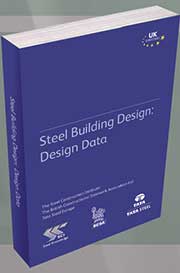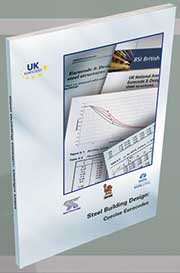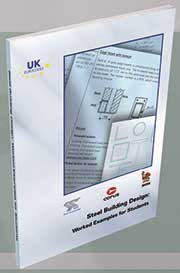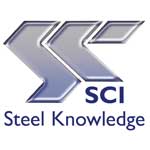Technical
Steel sector ready for eurocodes
The biggest change to codified building design ever in the UK will take effect in March, and the steel construction sector is fully prepared. Nick Barrett reports on the launch of the first tranche of design guides that will support the change.
One of the keys to success in using the new Eurocodes will be getting properly to grips with the content of the accompanying National Annexes, speakers stressed at the Eurocodes steel design guides launch in London. But all the advice and guidance that designers need will be to hand from the steel construction sector.
Event chairman Chris Dolling of Corus hailed the introduction of the Eurocodes as the most significant development ever in UK design codes. Mr Dolling said that extensive experience of the steel construction sector with the development of the Eurocodes meant that there was a wealth of knowledge for designers to call on to support the move to Eurocodes. “Eurocodes will quickly become the accepted standard in the UK,” he predicted. “They are all that future graduates will know of and design offices would find it inefficient to run both Eurocodes and BS5950 side by side.”
David Brown, Associate Director of SCI, said there were significant challenges associated with Eurocodes coming into effect in March 2010, but he stressed that they were manageable. “Nothing fundamental is changing, it is still the same physics after all, albeit presented in a different way. The importance of the National Annexes has to be emphasised as it is easy to miss something important if you fail to study them properly”, he said. Every design office should have at least one person whose job it is to get a tight grip on the National Annexes, as serious errors could be made.
There is a multitude of documents to be grappled with as well as the key National Annexes, but there is nothing that cannot be managed quite easily, and all the problems that are likely to arise with their introduction are solvable. Issues are a lack of familiarity that will vanish with modest experience.
Among the key presentational changes are that resistance checks are presented by structural phenomena, not design route. There are fewer look up tables and hardly a graph to be seen. There will be an increase in the use of equations, with more use of Greek symbols, and a lot of subscripts.
Advantages from using the Eurocodes will soon become apparent, predicted Mr Brown, who reinforced this in some technical demonstrations along with SCI’s Edurne Nunez Moreno. An 8% reduction in floor loadings would be one economical outcome from using the Eurocodes.
Mr Brown concluded that if he were to return to working as a steelwork contractor, he would without hesitation choose to use the Eurocodes for design immediately. “Designers will quickly see the advantages.”
BCSA’s Dr David Moore explained that the steel sector’s approach to supporting the introduction of Eurocodes has been different from the route chosen by some other sectors. The steel approach has been to develop pan European resources to as great an extent as possible, and to deliver them free as web based assets and to continuously improve and expand these assets.
A wealth of resources is available to designers and the core asset is Access-steel (www.access-steel.com). This has been funded by seven European steel producers with support from the European Union, developed by a consortium of technical institutes in the UK, France, Germany, Spain and Sweden. It contains 250 items of core information, including 11 interactive worked examples relevant to multi-storey building design
Courses are being provided by the SCI and others as required. SCI for example runs a two day course on Essential Steel Design to both BS5950 and EC3 as well as one day courses on steel buildings and steel bridge design to EC3. Courses can be organised in-house; and companies and other organisations can cost effectively combine to hold in-house courses. (www.steel-sci.org/Courses).
A useful route into advice is simply to google Steel NCCI where the relevant NCCI’s (Non Contradictory Complementary Information) is listed and can be searched by text or clause, queries can be forwarded to the relevant UK steel sector experts and useful links are provided. The NCCI’s contain guidance supporting the use of Eurocodes that is not provided in the Eurocodes themselves.
Dr Moore outlined the responses of commercial steel software developers to the introduction of Eurocodes, with all of them either having made, or are making, substantial progress in ensuring that familiar software can continue to be easily used. Other publications and website based material will continue to be produced including a publication to be called Eurocode Load Combinations for Steel Structures, which can be obtained via the BCSA’s website www.steelconstruction.org
Also for the future, Dr Moore said there are moves afoot to have sustainability addressed in Eurocodes. Designers are reminded that the Building Regulations in England and Wales allow any safe method of design to be used, including withdrawn British Standards. The Department for Communities and Local Government has decided to postpone amendments to Approved Document A – Structure until 2013. Consequently, AD-A will continue to reference British Standards such as BS 5950 as acceptable methods of complying with the Building Regulations.
The BCSA, Corus and SCI have produced a series of helpful design guides:
Steel Building Design: Introduction to the Eurocodes.
This is a high level document that introduces the Eurocode system and sets out the format used. It also explains the relationships between the Eurocodes, the National Annexes and Non-conflicting complementary Information (NCCI).
Steel Building Design: Concise Eurocodes.
This publication provides a concise compilation of the design recommendations for common building design in the UK based on the Eurocodes and the UK National Annexes.
Steel Building Design: Design Data (Blue book).
This publication presents design data in tabular format to assist engineers who are designing buildings in accordance with BS EN 1993-1-1: 2005, BS EN 1993-1-5: 2006 and BS EN 1993-1-8: 2005 and their respective National Annexes.
Steel Building Design: Worked Examples – Open Sections.
Includes worked examples for open sections and connections to the Eurocodes. These include restrained and un-restrained beams, columns in simple construction and simple connections (flexible end-plate).
Steel Building Design: Worked Examples – Hollow Sections.
Worked examples for hollow sections members including ties, beams, and columns in simple construction.
Steel Building Design: Worked examples for students.
This publication presents a brief introduction to the Eurocode system and worked examples based on a multi-storey building. Members (beams and columns) are taken for a multi-storey building and designed to the Eurocodes.
Steel Building Design: Medium Rise Braced Frames.
This is a Eurocode update of the existing publication on the design of medium rise buildings.
Eurocode Load Combinations for Steel Structures.
This publication presents practical guidance on combinations of actions (load combinations) for two principal types of steel structure – multi-storey buildings and industrial buildings.
Guides to be published next year include:
Handbook of Structural Steelwork (Eurocode version) (Red book).
Joints in Steel Construction – Simple Connections (Eurocode version).
Combined Torsion and Bending.
Also next year guides will be published for composite highway bridges, fire engineering, and composite members.
Useful Websites
Access Steel www.access-steel.com
Steel NCCI www.steel-ncci.co.uk
Corus Construction www.corusconstruction.com
BCSA www.steelconstruction.org
Steelbiz www.steelbiz.org
Steel Essentials www.steelessentials.info
New Steel Construction www.newsteelconstruction.com














